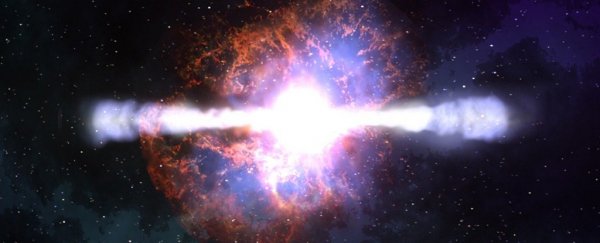An international team of scientists has captured the earliest images of supernovae in action - only minutes after ignition - and they say these massive stellar explosions are occurring after stars collide, challenging theories that supernova occur in a uniform way.
A supernova is a stellar explosion that can briefly outshine an entire galaxy, comprised of billions of stars. Using the Kepler space telescope, researchers photographed three of these cosmic events between 600 and 1.8 billion light-years from Earth.
They were looking specifically at type Ia supernovae, which involve the explosive deaths of ageing white dwarf stars that exist in a binary orbit with a sister star.
"We were able to capture the supernovae in the first minutes of the explosion, the earliest previously had been two-and-a-half hours after the event," astrophysicist and team member Brad Tucker, from the Australian National University, told Stuart Gary at ABC Science.
The team tracked the explosions in detail until they reached their pinnacle of brightness three weeks later, and then monitored the subsequent declines, as their light signatures faded away over the next few months.
They found that the initial stages of their supernovae didn't fit very well with prevailing theories about how they occur.
"The stars all blow up uniquely. It doesn't make sense," Tucker said in a press release. "It's particularly weird for these supernovae because even though their initial shockwaves are very different, they end up doing the same thing."
Before their study offered an unprecedented glimpse into the early stages of this stellar phenomena, astronomers only had information about what was happening in type Ia supernovae 2.5 hours after the star's explosive dying process had commenced.
What they observed was that after this 2.5-hour mark, the dying stars all followed an identical pattern. This led to theories that they might also originate in identical ways.
The prevailing theory has been that these explosions occur when the compact white dwarf - or the dying star - uses its gravity to pull hot material from its companion star onto its surface. Eventually, the added heat and pressure causes the star's core to explode.
But the team found no evidence of the supernovae ejecta interacting with a companion star, as might be expected.
"Somewhat to our surprise the results suggest an alternative hypothesis, that a violent collision between two smallish white dwarf stars sets off the explosion," lead researcher Robert Olling from the University of Maryland in the US, said in a press release.
The team's results, which were recently published in Nature, provide new insight into how some of these explosions form and could help astronomers use their light signatures to more accurately gauge cosmic distances between galaxies.
But it doesn't cancel out the other formation theory: a second paper published in the same issue of Nature by a different team has found evidence to support the view that these events can still be triggered by stars accreting matter from their companions.
The team from the California Institute of Technology used NASA's Swift space telescope to study a supernova 300-million-light-years away. They found that as the ejected material expanded outwards it eventually collided with the companion star. They say this provides evidence that the explosion is resulting from a single degenerating star, rather than a collision.
"As the blast wave hits the companion star it interacts with it and generates ultraviolet emissions which we detected with Swift," lead author and graduate student, Yi Cao, told ABC Science.
"We realised that this was probably the supernova companion interaction and we were very excited because we have been searching for this signal for a while."
